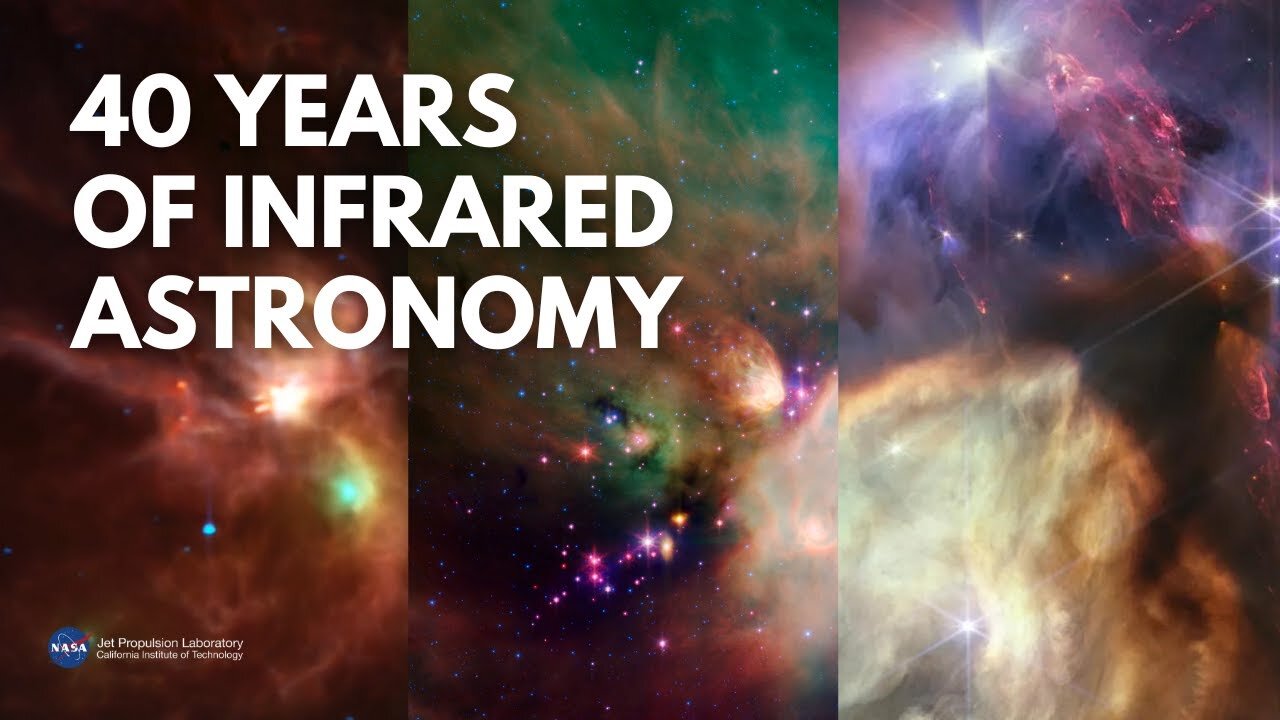Premium Only Content

NASA Telescopes Reveal an Invisible Infrared Universe
For 40 years, NASA has expanded our view of the universe with space telescopes that detect infrared light, which is invisible to the human eye. Observing the infrared realm helps us study the origins of planets, stars, galaxies, and even the universe itself.
NASA’s James Webb Space Telescope is the agency’s latest infrared space telescope, adding new insights to targets first discovered and studied by infrared missions that came before it.
Infrared space telescope missions have built upon one another to reveal stars, galaxies, and all manner of cosmic objects with ever-increasing clarity. Here you will see images from the pioneering Infrared Astronomical Satellite (IRAS), launched in 1983, the Spitzer Space Telescope, launched in 2003, and the James Webb Space Telescope, which launched in 2021 and is sending back extremely detailed images today.
For more information about Webb, visit: https://www.nasa.gov/webb
For more information about Spitzer, visit: https://www.nasa.gov/spitzer
For more information about IRAS, visit: https://www.jpl.nasa.gov/missions/inf...
Credits: IRAS images: NASA/Netherlands Agency for Aerospace Programmes/UK Science and Engineering Research Council/JPL-Caltech; Spitzer images: NASA/JPL-Caltech/IPAC; Webb images: NASA/ESA/CSA/STScI
For 40 years, NASA has expanded our view of the universe with space telescopes that detect infrared light, which is invisible to the human eye. Observing the infrared realm helps us study the origins of planets, stars, galaxies, and even the universe itself.
NASA’s James Webb Space Telescope is the agency’s latest infrared space telescope, adding new insights to targets first discovered and studied by infrared missions that came before it.
Infrared space telescope missions have built upon one another to reveal stars, galaxies, and all manner of cosmic objects with ever-increasing clarity. Here you will see images from the pioneering Infrared Astronomical Satellite (IRAS), launched in 1983, the Spitzer Space Telescope, launched in 2003, and the James Webb Space Telescope, which launched in 2021 and is sending back extremely detailed images today.
For more information about Webb, visit: https://www.nasa.gov/webb
For more information about Spitzer, visit: https://www.nasa.gov/spitzer
For more information about IRAS, visit: https://www.jpl.nasa.gov/missions/inf...
Credits: IRAS images: NASA/Netherlands Agency for Aerospace Programmes/UK Science and Engineering Research Council/JPL-Caltech; Spitzer images: NASA/JPL-Caltech/IPAC; Webb images: NASA/ESA/CSA/STScI
For 40 years, NASA has expanded our view of the universe with space telescopes that detect infrared light, which is invisible to the human eye. Observing the infrared realm helps us study the origins of planets, stars, galaxies, and even the universe itself.
NASA’s James Webb Space Telescope is the agency’s latest infrared space telescope, adding new insights to targets first discovered and studied by infrared missions that came before it.
Infrared space telescope missions have built upon one another to reveal stars, galaxies, and all manner of cosmic objects with ever-increasing clarity. Here you will see images from the pioneering Infrared Astronomical Satellite (IRAS), launched in 1983, the Spitzer Space Telescope, launched in 2003, and the James Webb Space Telescope, which launched in 2021 and is sending back extremely detailed images today.
For more information about Webb, visit: https://www.nasa.gov/webb
For more information about Spitzer, visit: https://www.nasa.gov/spitzer
For more information about IRAS, visit: https://www.jpl.nasa.gov/missions/inf...
Credits: IRAS images: NASA/Netherlands Agency for Aerospace Programmes/UK Science and Engineering Research Council/JPL-Caltech; Spitzer images: NASA/JPL-Caltech/IPAC; Webb images: NASA/ESA/CSA/STScI
For 40 years, NASA has expanded our view of the universe with space telescopes that detect infrared light, which is invisible to the human eye. Observing the infrared realm helps us study the origins of planets, stars, galaxies, and even the universe itself.
NASA’s James Webb Space Telescope is the agency’s latest infrared space telescope, adding new insights to targets first discovered and studied by infrared missions that came before it.
Infrared space telescope missions have built upon one another to reveal stars, galaxies, and all manner of cosmic objects with ever-increasing clarity. Here you will see images from the pioneering Infrared Astronomical Satellite (IRAS), launched in 1983, the Spitzer Space Telescope, launched in 2003, and the James Webb Space Telescope, which launched in 2021 and is sending back extremely detailed images today.
For more information about Webb, visit: https://www.nasa.gov/webb
For more information about Spitzer, visit: https://www.nasa.gov/spitzer
For more information about IRAS, visit: https://www.jpl.nasa.gov/missions/inf...
Credits: IRAS images: NASA/Netherlands Agency for Aerospace Programmes/UK Science and Engineering Research Council/JPL-Caltech; Spitzer images: NASA/JPL-Caltech/IPAC; Webb images: NASA/ESA/CSA/STScI
For 40 years, NASA has expanded our view of the universe with space telescopes that detect infrared light, which is invisible to the human eye. Observing the infrared realm helps us study the origins of planets, stars, galaxies, and even the universe itself.
NASA’s James Webb Space Telescope is the agency’s latest infrared space telescope, adding new insights to targets first discovered and studied by infrared missions that came before it.
Infrared space telescope missions have built upon one another to reveal stars, galaxies, and all manner of cosmic objects with ever-increasing clarity. Here you will see images from the pioneering Infrared Astronomical Satellite (IRAS), launched in 1983, the Spitzer Space Telescope, launched in 2003, and the James Webb Space Telescope, which launched in 2021 and is sending back extremely detailed images today.
For more information about Webb, visit: https://www.nasa.gov/webb
For more information about Spitzer, visit: https://www.nasa.gov/spitzer
For more information about IRAS, visit: https://www.jpl.nasa.gov/missions/inf...
Credits: IRAS images: NASA/Netherlands Agency for Aerospace Programmes/UK Science and Engineering Research Council/JPL-Caltech; Spitzer images: NASA/JPL-Caltech/IPAC; Webb images: NASA/ESA/CSA/STScI
For 40 years, NASA has expanded our view of the universe with space telescopes that detect infrared light, which is invisible to the human eye. Observing the infrared realm helps us study the origins of planets, stars, galaxies, and even the universe itself.
NASA’s James Webb Space Telescope is the agency’s latest infrared space telescope, adding new insights to targets first discovered and studied by infrared missions that came before it.
Infrared space telescope missions have built upon one another to reveal stars, galaxies, and all manner of cosmic objects with ever-increasing clarity. Here you will see images from the pioneering Infrared Astronomical Satellite (IRAS), launched in 1983, the Spitzer Space Telescope, launched in 2003, and the James Webb Space Telescope, which launched in 2021 and is sending back extremely detailed images today.
For more information about Webb, visit: https://www.nasa.gov/webb
For more information about Spitzer, visit: https://www.nasa.gov/spitzer
For more information about IRAS, visit: https://www.jpl.nasa.gov/missions/inf...
Credits: IRAS images: NASA/Netherlands Agency for Aerospace Programmes/UK Science and Engineering Research Council/JPL-Caltech; Spitzer images: NASA/JPL-Caltech/IPAC; Webb images: NASA/ESA/CSA/STScI
For 40 years, NASA has expanded our view of the universe with space telescopes that detect infrared light, which is invisible to the human eye. Observing the infrared realm helps us study the origins of planets, stars, galaxies, and even the universe itself.
NASA’s James Webb Space Telescope is the agency’s latest infrared space telescope, adding new insights to targets first discovered and studied by infrared missions that came before it.
Infrared space telescope missions have built upon one another to reveal stars, galaxies, and all manner of cosmic objects with ever-increasing clarity. Here you will see images from the pioneering Infrared Astronomical Satellite (IRAS), launched in 1983, the Spitzer Space Telescope, launched in 2003, and the James Webb Space Telescope, which launched in 2021 and is sending back extremely detailed images today.
For more information about Webb, visit: https://www.nasa.gov/webb
For more information about Spitzer, visit: https://www.nasa.gov/spitzer
For more information about IRAS, visit: https://www.jpl.nasa.gov/missions/inf...
Credits: IRAS images: NASA/Netherlands Agency for Aerospace Programmes/UK Science and Engineering Research Council/JPL-Caltech; Spitzer images: NASA/JPL-Caltech/IPAC; Webb images: NASA/ESA/CSA/STScI
For 40 years, NASA has expanded our view of the universe with space telescopes that detect infrared light, which is invisible to the human eye. Observing the infrared realm helps us study the origins of planets, stars, galaxies, and even the universe itself.
NASA’s James Webb Space Telescope is the agency’s latest infrared space telescope, adding new insights to targets first discovered and studied by infrared missions that came before it.
Infrared space telescope missions have built upon one another to reveal stars, galaxies, and all manner of cosmic objects with ever-increasing clarity. Here you will see images from the pioneering Infrared Astronomical Satellite (IRAS), launched in 1983, the Spitzer Space Telescope, launched in 2003, and the James Webb Space Telescope, which launched in 2021 and is sending back extremely detailed images today.
For more information about Webb, visit: https://www.nasa.gov/webb
For more information about Spitzer, visit: https://www.nasa.gov/spitzer
For more information about IRAS, visit: https://www.jpl.nasa.gov/missions/inf...
Credits: IRAS images: NASA/Netherlands Agency for Aerospace Programmes/UK Science and Engineering Research Council/JPL-Caltech; Spitzer images: NASA/JPL-Caltech/IPAC; Webb images: NASA/ESA/CSA/STScI
For 40 years, NASA has expanded our view of the universe with space telescopes that detect infrared light, which is invisible to the human eye. Observing the infrared realm helps us study the origins of planets, stars, galaxies, and even the universe itself.
NASA’s James Webb Space Telescope is the agency’s latest infrared space telescope, adding new insights to targets first discovered and studied by infrared missions that came before it.
Infrared space telescope missions have built upon one another to reveal stars, galaxies, and all manner of cosmic objects with ever-increasing clarity. Here you will see images from the pioneering Infrared Astronomical Satellite (IRAS), launched in 1983, the Spitzer Space Telescope, launched in 2003, and the James Webb Space Telescope, which launched in 2021 and is sending back extremely detailed images today.
For more information about Webb, visit: https://www.nasa.gov/webb
For more information about Spitzer, visit: https://www.nasa.gov/spitzer
For more information about IRAS, visit: https://www.jpl.nasa.gov/missions/inf...
Credits: IRAS images: NASA/Netherlands Agency for Aerospace Programmes/UK Science and Engineering Research Council/JPL-Caltech; Spitzer images: NASA/JPL-Caltech/IPAC; Webb images: NASA/ESA/CSA/STScI
For 40 years, NASA has expanded our view of the universe with space telescopes that detect infrared light, which is invisible to the human eye. Observing the infrared realm helps us study the origins of planets, stars, galaxies, and even the universe itself.
NASA’s James Webb Space Telescope is the agency’s latest infrared space telescope, adding new insights to targets first discovered and studied by infrared missions that came before it.
Infrared space telescope missions have built upon one another to reveal stars, galaxies, and all manner of cosmic objects with ever-increasing clarity. Here you will see images from the pioneering Infrared Astronomical Satellite (IRAS), launched in 1983, the Spitzer Space Telescope, launched in 2003, and the James Webb Space Telescope, which launched in 2021 and is sending back extremely detailed images today.
For more information about Webb, visit: https://www.nasa.gov/webb
For more information about Spitzer, visit: https://www.nasa.gov/spitzer
For more information about IRAS, visit: https://www.jpl.nasa.gov/missions/inf...
Credits: IRAS images: NASA/Netherlands Agency for Aerospace Programmes/UK Science and Engineering Research Council/JPL-Caltech; Spitzer images: NASA/JPL-Caltech/IPAC; Webb images: NASA/ESA/CSA/STScI
For 40 years, NASA has expanded our view of the universe with space telescopes that detect infrared light, which is invisible to the human eye. Observing the infrared realm helps us study the origins of planets, stars, galaxies, and even the universe itself.
NASA’s James Webb Space Telescope is the agency’s latest infrared space telescope, adding new insights to targets first discovered and studied by infrared missions that came before it.
Infrared space telescope missions have built upon one another to reveal stars, galaxies, and all manner of cosmic objects with ever-increasing clarity. Here you will see images from the pioneering Infrared Astronomical Satellite (IRAS), launched in 1983, the Spitzer Space Telescope, launched in 2003, and the James Webb Space Telescope, which launched in 2021 and is sending back extremely detailed images today.
For more information about Webb, visit: https://www.nasa.gov/webb
For more information about Spitzer, visit: https://www.nasa.gov/spitzer
For more information about IRAS, visit: https://www.jpl.nasa.gov/missions/inf...
Credits: IRAS images: NASA/Netherlands Agency for Aerospace Programmes/UK Science and Engineering Research Council/JPL-Caltech; Spitzer images: NASA/JPL-Caltech/IPAC; Webb images: NASA/ESA/CSA/STScI
For 40 years, NASA has expanded our view of the universe with space telescopes that detect infrared light, which is invisible to the human eye. Observing the infrared realm helps us study the origins of planets, stars, galaxies, and even the universe itself.
NASA’s James Webb Space Telescope is the agency’s latest infrared space telescope, adding new insights to targets first discovered and studied by infrared missions that came before it.
Infrared space telescope missions have built upon one another to reveal stars, galaxies, and all manner of cosmic objects with ever-increasing clarity. Here you will see images from the pioneering Infrared Astronomical Satellite (IRAS), launched in 1983, the Spitzer Space Telescope, launched in 2003, and the James Webb Space Telescope, which launched in 2021 and is sending back extremely detailed images today.
For more information about Webb, visit: https://www.nasa.gov/webb
For more information about Spitzer, visit: https://www.nasa.gov/spitzer
For more information about IRAS, visit: https://www.jpl.nasa.gov/missions/inf...
Credits: IRAS images: NASA/Netherlands Agency for Aerospace Programmes/UK Science and Engineering Research Council/JPL-Caltech; Spitzer images: NASA/JPL-Caltech/IPAC; Webb images: NASA/ESA/CSA/STScI
For 40 years, NASA has expanded our view of the universe with space telescopes that detect infrared light, which is invisible to the human eye. Observing the infrared realm helps us study the origins of planets, stars, galaxies, and even the universe itself.
NASA’s James Webb Space Telescope is the agency’s latest infrared space telescope, adding new insights to targets first discovered and studied by infrared missions that came before it.
Infrared space telescope missions have built upon one another to reveal stars, galaxies, and all manner of cosmic objects with ever-increasing clarity. Here you will see images from the pioneering Infrared Astronomical Satellite (IRAS), launched in 1983, the Spitzer Space Telescope, launched in 2003, and the James Webb Space Telescope, which launched in 2021 and is sending back extremely detailed images today.
For more information about Webb, visit: https://www.nasa.gov/webb
For more information about Spitzer, visit: https://www.nasa.gov/spitzer
For more information about IRAS, visit: https://www.jpl.nasa.gov/missions/inf...
Credits: IRAS images: NASA/Netherlands Agency for Aerospace Programmes/UK Science and Engineering Research Council/JPL-Caltech; Spitzer images: NASA/JPL-Caltech/IPAC; Webb images: NASA/ESA/CSA/STScI
For 40 years, NASA has expanded our view of the universe with space telescopes that detect infrared light, which is invisible to the human eye. Observing the infrared realm helps us study the origins of planets, stars, galaxies, and even the universe itself.
NASA’s James Webb Space Telescope is the agency’s latest infrared space telescope, adding new insights to targets first discovered and studied by infrared missions that came before it.
Infrared space telescope missions have built upon one another to reveal stars, galaxies, and all manner of cosmic objects with ever-increasing clarity. Here you will see images from the pioneering Infrared Astronomical Satellite (IRAS), launched in 1983, the Spitzer Space Telescope, launched in 2003, and the James Webb Space Telescope, which launched in 2021 and is sending back extremely detailed images today.
For more information about Webb, visit: https://www.nasa.gov/webb
For more information about Spitzer, visit: https://www.nasa.gov/spitzer
For more information about IRAS, visit: https://www.jpl.nasa.gov/missions/inf...
Credits: IRAS images: NASA/Netherlands Agency for Aerospace Programmes/UK Science and Engineering Research Council/JPL-Caltech; Spitzer images: NASA/JPL-Caltech/IPAC; Webb images: NASA/ESA/CSA/STScI
For 40 years, NASA has expanded our view of the universe with space telescopes that detect infrared light, which is invisible to the human eye. Observing the infrared realm helps us study the origins of planets, stars, galaxies, and even the universe itself.
NASA’s James Webb Space Telescope is the agency’s latest infrared space telescope, adding new insights to targets first discovered and studied by infrared missions that came before it.
Infrared space telescope missions have built upon one another to reveal stars, galaxies, and all manner of cosmic objects with ever-increasing clarity. Here you will see images from the pioneering Infrared Astronomical Satellite (IRAS), launched in 1983, the Spitzer Space Telescope, launched in 2003, and the James Webb Space Telescope, which launched in 2021 and is sending back extremely detailed images today.
For more information about Webb, visit: https://www.nasa.gov/webb
For more information about Spitzer, visit: https://www.nasa.gov/spitzer
For more information about IRAS, visit: https://www.jpl.nasa.gov/missions/inf...
Credits: IRAS images: NASA/Netherlands Agency for Aerospace Programmes/UK Science and Engineering Research Council/JPL-Caltech; Spitzer images: NASA/JPL-Caltech/IPAC; Webb images: NASA/ESA/CSA/STScI
For 40 years, NASA has expanded our view of the universe with space telescopes that detect infrared light, which is invisible to the human eye. Observing the infrared realm helps us study the origins of planets, stars, galaxies, and even the universe itself.
NASA’s James Webb Space Telescope is the agency’s latest infrared space telescope, adding new insights to targets first discovered and studied by infrared missions that came before it.
Infrared space telescope missions have built upon one another to reveal stars, galaxies, and all manner of cosmic objects with ever-increasing clarity. Here you will see images from the pioneering Infrared Astronomical Satellite (IRAS), launched in 1983, the Spitzer Space Telescope, launched in 2003, and the James Webb Space Telescope, which launched in 2021 and is sending back extremely detailed images today.
For more information about Webb, visit: https://www.nasa.gov/webb
For more information about Spitzer, visit: https://www.nasa.gov/spitzer
For more information about IRAS, visit: https://www.jpl.nasa.gov/missions/inf...
Credits: IRAS images: NASA/Netherlands Agency for Aerospace Programmes/UK Science and Engineering Research Council/JPL-Caltech; Spitzer images: NASA/JPL-Caltech/IPAC; Webb images: NASA/ESA/CSA/STScI
For 40 years, NASA has expanded our view of the universe with space telescopes that detect infrared light, which is invisible to the human eye. Observing the infrared realm helps us study the origins of planets, stars, galaxies, and even the universe itself.
NASA’s James Webb Space Telescope is the agency’s latest infrared space telescope, adding new insights to targets first discovered and studied by infrared missions that came before it.
Infrared space telescope missions have built upon one another to reveal stars, galaxies, and all manner of cosmic objects with ever-increasing clarity. Here you will see images from the pioneering Infrared Astronomical Satellite (IRAS), launched in 1983, the Spitzer Space Telescope, launched in 2003, and the James Webb Space Telescope, which launched in 2021 and is sending back extremely detailed images today.
For more information about Webb, visit: https://www.nasa.gov/webb
For more information about Spitzer, visit: https://www.nasa.gov/spitzer
For more information about IRAS, visit: https://www.jpl.nasa.gov/missions/inf...
Credits: IRAS images: NASA/Netherlands Agency for Aerospace Programmes/UK Science and Engineering Research Council/JPL-Caltech; Spitzer images: NASA/JPL-Caltech/IPAC; Webb images: NASA/ESA/CSA/STScI
For 40 years, NASA has expanded our view of the universe with space telescopes that detect infrared light, which is invisible to the human eye. Observing the infrared realm helps us study the origins of planets, stars, galaxies, and even the universe itself.
NASA’s James Webb Space Telescope is the agency’s latest infrared space telescope, adding new insights to targets first discovered and studied by infrared missions that came before it.
Infrared space telescope missions have built upon one another to reveal stars, galaxies, and all manner of cosmic objects with ever-increasing clarity. Here you will see images from the pioneering Infrared Astronomical Satellite (IRAS), launched in 1983, the Spitzer Space Telescope, launched in 2003, and the James Webb Space Telescope, which launched in 2021 and is sending back extremely detailed images today.
For more information about Webb, visit: https://www.nasa.gov/webb
For more information about Spitzer, visit: https://www.nasa.gov/spitzer
For more information about IRAS, visit: https://www.jpl.nasa.gov/missions/inf...
Credits: IRAS images: NASA/Netherlands Agency for Aerospace Programmes/UK Science and Engineering Research Council/JPL-Caltech; Spitzer images: NASA/JPL-Caltech/IPAC; Webb images: NASA/ESA/CSA/STScI
For 40 years, NASA has expanded our view of the universe with space telescopes that detect infrared light, which is invisible to the human eye. Observing the infrared realm helps us study the origins of planets, stars, galaxies, and even the universe itself.
NASA’s James Webb Space Telescope is the agency’s latest infrared space telescope, adding new insights to targets first discovered and studied by infrared missions that came before it.
Infrared space telescope missions have built upon one another to reveal stars, galaxies, and all manner of cosmic objects with ever-increasing clarity. Here you will see images from the pioneering Infrared Astronomical Satellite (IRAS), launched in 1983, the Spitzer Space Telescope, launched in 2003, and the James Webb Space Telescope, which launched in 2021 and is sending back extremely detailed images today.
For more information about Webb, visit: https://www.nasa.gov/webb
For more information about Spitzer, visit: https://www.nasa.gov/spitzer
For more information about IRAS, visit: https://www.jpl.nasa.gov/missions/inf...
Credits: IRAS images: NASA/Netherlands Agency for Aerospace Programmes/UK Science and Engineering Research Council/JPL-Caltech; Spitzer images: NASA/JPL-Caltech/IPAC; Webb images: NASA/ESA/CSA/STScI
For 40 years, NASA has expanded our view of the universe with space telescopes that detect infrared light, which is invisible to the human eye. Observing the infrared realm helps us study the origins of planets, stars, galaxies, and even the universe itself.
NASA’s James Webb Space Telescope is the agency’s latest infrared space telescope, adding new insights to targets first discovered and studied by infrared missions that came before it.
Infrared space telescope missions have built upon one another to reveal stars, galaxies, and all manner of cosmic objects with ever-increasing clarity. Here you will see images from the pioneering Infrared Astronomical Satellite (IRAS), launched in 1983, the Spitzer Space Telescope, launched in 2003, and the James Webb Space Telescope, which launched in 2021 and is sending back extremely detailed images today.
For more information about Webb, visit: https://www.nasa.gov/webb
For more information about Spitzer, visit: https://www.nasa.gov/spitzer
For more information about IRAS, visit: https://www.jpl.nasa.gov/missions/inf...
Credits: IRAS images: NASA/Netherlands Agency for Aerospace Programmes/UK Science and Engineering Research Council/JPL-Caltech; Spitzer images: NASA/JPL-Caltech/IPAC; Webb images: NASA/ESA/CSA/STScI
For 40 years, NASA has expanded our view of the universe with space telescopes that detect infrared light, which is invisible to the human eye. Observing the infrared realm helps us study the origins of planets, stars, galaxies, and even the universe itself.
NASA’s James Webb Space Telescope is the agency’s latest infrared space telescope, adding new insights to targets first discovered and studied by infrared missions that came before it.
Infrared space telescope missions have built upon one another to reveal stars, galaxies, and all manner of cosmic objects with ever-increasing clarity. Here you will see images from the pioneering Infrared Astronomical Satellite (IRAS), launched in 1983, the Spitzer Space Telescope, launched in 2003, and the James Webb Space Telescope, which launched in 2021 and is sending back extremely detailed images today.
For more information about Webb, visit: https://www.nasa.gov/webb
For more information about Spitzer, visit: https://www.nasa.gov/spitzer
For more information about IRAS, visit: https://www.jpl.nasa.gov/missions/inf...
Credits: IRAS images: NASA/Netherlands Agency for Aerospace Programmes/UK Science and Engineering Research Council/JPL-Caltech; Spitzer images: NASA/JPL-Caltech/IPAC; Webb images: NASA/ESA/CSA/STScI
For 40 years, NASA has expanded our view of the universe with space telescopes that detect infrared light, which is invisible to the human eye. Observing the infrared realm helps us study the origins of planets, stars, galaxies, and even the universe itself.
NASA’s James Webb Space Telescope is the agency’s latest infrared space telescope, adding new insights to targets first discovered and studied by infrared missions that came before it.
Infrared space telescope missions have built upon one another to reveal stars, galaxies, and all manner of cosmic objects with ever-increasing clarity. Here you will see images from the pioneering Infrared Astronomical Satellite (IRAS), launched in 1983, the Spitzer Space Telescope, launched in 2003, and the James Webb Space Telescope, which launched in 2021 and is sending back extremely detailed images today.
For more information about Webb, visit: https://www.nasa.gov/webb
For more information about Spitzer, visit: https://www.nasa.gov/spitzer
For more information about IRAS, visit: https://www.jpl.nasa.gov/missions/inf...
Credits: IRAS images: NASA/Netherlands Agency for Aerospace Programmes/UK Science and Engineering Research Council/JPL-Caltech; Spitzer images: NASA/JPL-Caltech/IPAC; Webb images: NASA/ESA/CSA/STScI
For 40 years, NASA has expanded our view of the universe with space telescopes that detect infrared light, which is invisible to the human eye. Observing the infrared realm helps us study the origins of planets, stars, galaxies, and even the universe itself.
NASA’s James Webb Space Telescope is the agency’s latest infrared space telescope, adding new insights to targets first discovered and studied by infrared missions that came before it.
Infrared space telescope missions have built upon one another to reveal stars, galaxies, and all manner of cosmic objects with ever-increasing clarity. Here you will see images from the pioneering Infrared Astronomical Satellite (IRAS), launched in 1983, the Spitzer Space Telescope, launched in 2003, and the James Webb Space Telescope, which launched in 2021 and is sending back extremely detailed images today.
For more information about Webb, visit: https://www.nasa.gov/webb
For more information about Spitzer, visit: https://www.nasa.gov/spitzer
For more information about IRAS, visit: https://www.jpl.nasa.gov/missions/inf...
Credits: IRAS images: NASA/Netherlands Agency for Aerospace Programmes/UK Science and Engineering Research Council/JPL-Caltech; Spitzer images: NASA/JPL-Caltech/IPAC; Webb images: NASA/ESA/CSA/STScI
For 40 years, NASA has expanded our view of the universe with space telescopes that detect infrared light, which is invisible to the human eye. Observing the infrared realm helps us study the origins of planets, stars, galaxies, and even the universe itself.
NASA’s James Webb Space Telescope is the agency’s latest infrared space telescope, adding new insights to targets first discovered and studied by infrared missions that came before it.
Infrared space telescope missions have built upon one another to reveal stars, galaxies, and all manner of cosmic objects with ever-increasing clarity. Here you will see images from the pioneering Infrared Astronomical Satellite (IRAS), launched in 1983, the Spitzer Space Telescope, launched in 2003, and the James Webb Space Telescope, which launched in 2021 and is sending back extremely detailed images today.
For more information about Webb, visit: https://www.nasa.gov/webb
For more information about Spitzer, visit: https://www.nasa.gov/spitzer
For more information about IRAS, visit: https://www.jpl.nasa.gov/missions/inf...
Credits: IRAS images: NASA/Netherlands Agency for Aerospace Programmes/UK Science and Engineering Research Council/JPL-Caltech; Spitzer images: NASA/JPL-Caltech/IPAC; Webb images: NASA/ESA/CSA/STScI
For 40 years, NASA has expanded our view of the universe with space telescopes that detect infrared light, which is invisible to the human eye. Observing the infrared realm helps us study the origins of planets, stars, galaxies, and even the universe itself.
NASA’s James Webb Space Telescope is the agency’s latest infrared space telescope, adding new insights to targets first discovered and studied by infrared missions that came before it.
Infrared space telescope missions have built upon one another to reveal stars, galaxies, and all manner of cosmic objects with ever-increasing clarity. Here you will see images from the pioneering Infrared Astronomical Satellite (IRAS), launched in 1983, the Spitzer Space Telescope, launched in 2003, and the James Webb Space Telescope, which launched in 2021 and is sending back extremely detailed images today.
For more information about Webb, visit: https://www.nasa.gov/webb
For more information about Spitzer, visit: https://www.nasa.gov/spitzer
For more information about IRAS, visit: https://www.jpl.nasa.gov/missions/inf...
Credits: IRAS images: NASA/Netherlands Agency for Aerospace Programmes/UK Science and Engineering Research Council/JPL-Caltech; Spitzer images: NASA/JPL-Caltech/IPAC; Webb images: NASA/ESA/CSA/STScI
For 40 years, NASA has expanded our view of the universe with space telescopes that detect infrared light, which is invisible to the human eye. Observing the infrared realm helps us study the origins of planets, stars, galaxies, and even the universe itself.
NASA’s James Webb Space Telescope is the agency’s latest infrared space telescope, adding new insights to targets first discovered and studied by infrared missions that came before it.
Infrared space telescope missions have built upon one another to reveal stars, galaxies, and all manner of cosmic objects with ever-increasing clarity. Here you will see images from the pioneering Infrared Astronomical Satellite (IRAS), launched in 1983, the Spitzer Space Telescope, launched in 2003, and the James Webb Space Telescope, which launched in 2021 and is sending back extremely detailed images today.
For more information about Webb, visit: https://www.nasa.gov/webb
For more information about Spitzer, visit: https://www.nasa.gov/spitzer
For more information about IRAS, visit: https://www.jpl.nasa.gov/missions/inf...
Credits: IRAS images: NASA/Netherlands Agency for Aerospace Programmes/UK Science and Engineering Research Council/JPL-Caltech; Spitzer images: NASA/JPL-Caltech/IPAC; Webb images: NASA/ESA/CSA/STScI
For 40 years, NASA has expanded our view of the universe with space telescopes that detect infrared light, which is invisible to the human eye. Observing the infrared realm helps us study the origins of planets, stars, galaxies, and even the universe itself.
NASA’s James Webb Space Telescope is the agency’s latest infrared space telescope, adding new insights to targets first discovered and studied by infrared missions that came before it.
Infrared space telescope missions have built upon one another to reveal stars, galaxies, and all manner of cosmic objects with ever-increasing clarity. Here you will see images from the pioneering Infrared Astronomical Satellite (IRAS), launched in 1983, the Spitzer Space Telescope, launched in 2003, and the James Webb Space Telescope, which launched in 2021 and is sending back extremely detailed images today.
For more information about Webb, visit: https://www.nasa.gov/webb
For more information about Spitzer, visit: https://www.nasa.gov/spitzer
For more information about IRAS, visit: https://www.jpl.nasa.gov/missions/inf...
Credits: IRAS images: NASA/Netherlands Agency for Aerospace Programmes/UK Science and Engineering Research Council/JPL-Caltech; Spitzer images: NASA/JPL-Caltech/IPAC; Webb images: NASA/ESA/CSA/STScI
For 40 years, NASA has expanded our view of the universe with space telescopes that detect infrared light, which is invisible to the human eye. Observing the infrared realm helps us study the origins of planets, stars, galaxies, and even the universe itself.
NASA’s James Webb Space Telescope is the agency’s latest infrared space telescope, adding new insights to targets first discovered and studied by infrared missions that came before it.
Infrared space telescope missions have built upon one another to reveal stars, galaxies, and all manner of cosmic objects with ever-increasing clarity. Here you will see images from the pioneering Infrared Astronomical Satellite (IRAS), launched in 1983, the Spitzer Space Telescope, launched in 2003, and the James Webb Space Telescope, which launched in 2021 and is sending back extremely detailed images today.
For more information about Webb, visit: https://www.nasa.gov/webb
For more information about Spitzer, visit: https://www.nasa.gov/spitzer
For more information about IRAS, visit: https://www.jpl.nasa.gov/missions/inf...
Credits: IRAS images: NASA/Netherlands Agency for Aerospace Programmes/UK Science and Engineering Research Council/JPL-Caltech; Spitzer images: NASA/JPL-Caltech/IPAC; Webb images: NASA/ESA/CSA/STScI
For 40 years, NASA has expanded our view of the universe with space telescopes that detect infrared light, which is invisible to the human eye. Observing the infrared realm helps us study the origins of planets, stars, galaxies, and even the universe itself.
NASA’s James Webb Space Telescope is the agency’s latest infrared space telescope, adding new insights to targets first discovered and studied by infrared missions that came before it.
Infrared space telescope missions have built upon one another to reveal stars, galaxies, and all manner of cosmic objects with ever-increasing clarity. Here you will see images from the pioneering Infrared Astronomical Satellite (IRAS), launched in 1983, the Spitzer Space Telescope, launched in 2003, and the James Webb Space Telescope, which launched in 2021 and is sending back extremely detailed images today.
For more information about Webb, visit: https://www.nasa.gov/webb
For more information about Spitzer, visit: https://www.nasa.gov/spitzer
For more information about IRAS, visit: https://www.jpl.nasa.gov/missions/inf...
Credits: IRAS images: NASA/Netherlands Agency for Aerospace Programmes/UK Science and Engineering Research Council/JPL-Caltech; Spitzer images: NASA/JPL-Caltech/IPAC; Webb images: NASA/ESA/CSA/STScI
For 40 years, NASA has expanded our view of the universe with space telescopes that detect infrared light, which is invisible to the human eye. Observing the infrared realm helps us study the origins of planets, stars, galaxies, and even the universe itself.
NASA’s James Webb Space Telescope is the agency’s latest infrared space telescope, adding new insights to targets first discovered and studied by infrared missions that came before it.
Infrared space telescope missions have built upon one another to reveal stars, galaxies, and all manner of cosmic objects with ever-increasing clarity. Here you will see images from the pioneering Infrared Astronomical Satellite (IRAS), launched in 1983, the Spitzer Space Telescope, launched in 2003, and the James Webb Space Telescope, which launched in 2021 and is sending back extremely detailed images today.
For more information about Webb, visit: https://www.nasa.gov/webb
For more information about Spitzer, visit: https://www.nasa.gov/spitzer
For more information about IRAS, visit: https://www.jpl.nasa.gov/missions/inf...
Credits: IRAS images: NASA/Netherlands Agency for Aerospace Programmes/UK Science and Engineering Research Council/JPL-Caltech; Spitzer images: NASA/JPL-Caltech/IPAC; Webb images: NASA/ESA/CSA/STScI
For 40 years, NASA has expanded our view of the universe with space telescopes that detect infrared light, which is invisible to the human eye. Observing the infrared realm helps us study the origins of planets, stars, galaxies, and even the universe itself.
NASA’s James Webb Space Telescope is the agency’s latest infrared space telescope, adding new insights to targets first discovered and studied by infrared missions that came before it.
Infrared space telescope missions have built upon one another to reveal stars, galaxies, and all manner of cosmic objects with ever-increasing clarity. Here you will see images from the pioneering Infrared Astronomical Satellite (IRAS), launched in 1983, the Spitzer Space Telescope, launched in 2003, and the James Webb Space Telescope, which launched in 2021 and is sending back extremely detailed images today.
For more information about Webb, visit: https://www.nasa.gov/webb
For more information about Spitzer, visit: https://www.nasa.gov/spitzer
For more information about IRAS, visit: https://www.jpl.nasa.gov/missions/inf...
Credits: IRAS images: NASA/Netherlands Agency for Aerospace Programmes/UK Science and Engineering Research Council/JPL-Caltech; Spitzer images: NASA/JPL-Caltech/IPAC; Webb images: NASA/ESA/CSA/STScI
For 40 years, NASA has expanded our view of the universe with space telescopes that detect infrared light, which is invisible to the human eye. Observing the infrared realm helps us study the origins of planets, stars, galaxies, and even the universe itself.
NASA’s James Webb Space Telescope is the agency’s latest infrared space telescope, adding new insights to targets first discovered and studied by infrared missions that came before it.
Infrared space telescope missions have built upon one another to reveal stars, galaxies, and all manner of cosmic objects with ever-increasing clarity. Here you will see images from the pioneering Infrared Astronomical Satellite (IRAS), launched in 1983, the Spitzer Space Telescope, launched in 2003, and the James Webb Space Telescope, which launched in 2021 and is sending back extremely detailed images today.
For more information about Webb, visit: https://www.nasa.gov/webb
For more information about Spitzer, visit: https://www.nasa.gov/spitzer
For more information about IRAS, visit: https://www.jpl.nasa.gov/missions/inf...
Credits: IRAS images: NASA/Netherlands Agency for Aerospace Programmes/UK Science and Engineering Research Council/JPL-Caltech; Spitzer images: NASA/JPL-Caltech/IPAC; Webb images: NASA/ESA/CSA/STScI
For 40 years, NASA has expanded our view of the universe with space telescopes that detect infrared light, which is invisible to the human eye. Observing the infrared realm helps us study the origins of planets, stars, galaxies, and even the universe itself.
NASA’s James Webb Space Telescope is the agency’s latest infrared space telescope, adding new insights to targets first discovered and studied by infrared missions that came before it.
Infrared space telescope missions have built upon one another to reveal stars, galaxies, and all manner of cosmic objects with ever-increasing clarity. Here you will see images from the pioneering Infrared Astronomical Satellite (IRAS), launched in 1983, the Spitzer Space Telescope, launched in 2003, and the James Webb Space Telescope, which launched in 2021 and is sending back extremely detailed images today.
For more information about Webb, visit: https://www.nasa.gov/webb
For more information about Spitzer, visit: https://www.nasa.gov/spitzer
For more information about IRAS, visit: https://www.jpl.nasa.gov/missions/inf...
Credits: IRAS images: NASA/Netherlands Agency for Aerospace Programmes/UK Science and Engineering Research Council/JPL-Caltech; Spitzer images: NASA/JPL-Caltech/IPAC; Webb images: NASA/ESA/CSA/STScI
For 40 years, NASA has expanded our view of the universe with space telescopes that detect infrared light, which is invisible to the human eye. Observing the infrared realm helps us study the origins of planets, stars, galaxies, and even the universe itself.
NASA’s James Webb Space Telescope is the agency’s latest infrared space telescope, adding new insights to targets first discovered and studied by infrared missions that came before it.
Infrared space telescope missions have built upon one another to reveal stars, galaxies, and all manner of cosmic objects with ever-increasing clarity. Here you will see images from the pioneering Infrared Astronomical Satellite (IRAS), launched in 1983, the Spitzer Space Telescope, launched in 2003, and the James Webb Space Telescope, which launched in 2021 and is sending back extremely detailed images today.
For more information about Webb, visit: https://www.nasa.gov/webb
For more information about Spitzer, visit: https://www.nasa.gov/spitzer
For more information about IRAS, visit: https://www.jpl.nasa.gov/missions/inf...
Credits: IRAS images: NASA/Netherlands Agency for Aerospace Programmes/UK Science and Engineering Research Council/JPL-Caltech; Spitzer images: NASA/JPL-Caltech/IPAC; Webb images: NASA/ESA/CSA/STScI
For 40 years, NASA has expanded our view of the universe with space telescopes that detect infrared light, which is invisible to the human eye. Observing the infrared realm helps us study the origins of planets, stars, galaxies, and even the universe itself.
NASA’s James Webb Space Telescope is the agency’s latest infrared space telescope, adding new insights to targets first discovered and studied by infrared missions that came before it.
Infrared space telescope missions have built upon one another to reveal stars, galaxies, and all manner of cosmic objects with ever-increasing clarity. Here you will see images from the pioneering Infrared Astronomical Satellite (IRAS), launched in 1983, the Spitzer Space Telescope, launched in 2003, and the James Webb Space Telescope, which launched in 2021 and is sending back extremely detailed images today.
For more information about Webb, visit: https://www.nasa.gov/webb
For more information about Spitzer, visit: https://www.nasa.gov/spitzer
For more information about IRAS, visit: https://www.jpl.nasa.gov/missions/inf...
Credits: IRAS images: NASA/Netherlands Agency for Aerospace Programmes/UK Science and Engineering Research Council/JPL-Caltech; Spitzer images: NASA/JPL-Caltech/IPAC; Webb images: NASA/ESA/CSA/STScI
For 40 years, NASA has expanded our view of the universe with space telescopes that detect infrared light, which is invisible to the human eye. Observing the infrared realm helps us study the origins of planets, stars, galaxies, and even the universe itself.
NASA’s James Webb Space Telescope is the agency’s latest infrared space telescope, adding new insights to targets first discovered and studied by infrared missions that came before it.
Infrared space telescope missions have built upon one another to reveal stars, galaxies, and all manner of cosmic objects with ever-increasing clarity. Here you will see images from the pioneering Infrared Astronomical Satellite (IRAS), launched in 1983, the Spitzer Space Telescope, launched in 2003, and the James Webb Space Telescope, which launched in 2021 and is sending back extremely detailed images today.
For more information about Webb, visit: https://www.nasa.gov/webb
For more information about Spitzer, visit: https://www.nasa.gov/spitzer
For more information about IRAS, visit: https://www.jpl.nasa.gov/missions/inf...
Credits: IRAS images: NASA/Netherlands Agency for Aerospace Programmes/UK Science and Engineering Research Council/JPL-Caltech; Spitzer images: NASA/JPL-Caltech/IPAC; Webb images: NASA/ESA/CSA/STScI
For 40 years, NASA has expanded our view of the universe with space telescopes that detect infrared light, which is invisible to the human eye. Observing the infrared realm helps us study the origins of planets, stars, galaxies, and even the universe itself.
NASA’s James Webb Space Telescope is the agency’s latest infrared space telescope, adding new insights to targets first discovered and studied by infrared missions that came before it.
Infrared space telescope missions have built upon one another to reveal stars, galaxies, and all manner of cosmic objects with ever-increasing clarity. Here you will see images from the pioneering Infrared Astronomical Satellite (IRAS), launched in 1983, the Spitzer Space Telescope, launched in 2003, and the James Webb Space Telescope, which launched in 2021 and is sending back extremely detailed images today.
For more information about Webb, visit: https://www.nasa.gov/webb
For more information about Spitzer, visit: https://www.nasa.gov/spitzer
For more information about IRAS, visit: https://www.jpl.nasa.gov/missions/inf...
Credits: IRAS images: NASA/Netherlands Agency for Aerospace Programmes/UK Science and Engineering Research Council/JPL-Caltech; Spitzer images: NASA/JPL-Caltech/IPAC; Webb images: NASA/ESA/CSA/STScI
For 40 years, NASA has expanded our view of the universe with space telescopes that detect infrared light, which is invisible to the human eye. Observing the infrared realm helps us study the origins of planets, stars, galaxies, and even the universe itself.
NASA’s James Webb Space Telescope is the agency’s latest infrared space telescope, adding new insights to targets first discovered and studied by infrared missions that came before it.
Infrared space telescope missions have built upon one another to reveal stars, galaxies, and all manner of cosmic objects with ever-increasing clarity. Here you will see images from the pioneering Infrared Astronomical Satellite (IRAS), launched in 1983, the Spitzer Space Telescope, launched in 2003, and the James Webb Space Telescope, which launched in 2021 and is sending back extremely detailed images today.
For more information about Webb, visit: https://www.nasa.gov/webb
For more information about Spitzer, visit: https://www.nasa.gov/spitzer
For more information about IRAS, visit: https://www.jpl.nasa.gov/missions/inf...
Credits: IRAS images: NASA/Netherlands Agency for Aerospace Programmes/UK Science and Engineering Research Council/JPL-Caltech; Spitzer images: NASA/JPL-Caltech/IPAC; Webb images: NASA/ESA/CSA/STScI
For 40 years, NASA has expanded our view of the universe with space telescopes that detect infrared light, which is invisible to the human eye. Observing the infrared realm helps us study the origins of planets, stars, galaxies, and even the universe itself.
NASA’s James Webb Space Telescope is the agency’s latest infrared space telescope, adding new insights to targets first discovered and studied by infrared missions that came before it.
Infrared space telescope missions have built upon one another to reveal stars, galaxies, and all manner of cosmic objects with ever-increasing clarity. Here you will see images from the pioneering Infrared Astronomical Satellite (IRAS), launched in 1983, the Spitzer Space Telescope, launched in 2003, and the James Webb Space Telescope, which launched in 2021 and is sending back extremely detailed images today.
For more information about Webb, visit: https://www.nasa.gov/webb
For more information about Spitzer, visit: https://www.nasa.gov/spitzer
For more information about IRAS, visit: https://www.jpl.nasa.gov/missions/inf...
Credits: IRAS images: NASA/Netherlands Agency for Aerospace Programmes/UK Science and Engineering Research Council/JPL-Caltech; Spitzer images: NASA/JPL-Caltech/IPAC; Webb images: NASA/ESA/CSA/STScI
For 40 years, NASA has expanded our view of the universe with space telescopes that detect infrared light, which is invisible to the human eye. Observing the infrared realm helps us study the origins of planets, stars, galaxies, and even the universe itself.
NASA’s James Webb Space Telescope is the agency’s latest infrared space telescope, adding new insights to targets first discovered and studied by infrared missions that came before it.
Infrared space telescope missions have built upon one another to reveal stars, galaxies, and all manner of cosmic objects with ever-increasing clarity. Here you will see images from the pioneering Infrared Astronomical Satellite (IRAS), launched in 1983, the Spitzer Space Telescope, launched in 2003, and the James Webb Space Telescope, which launched in 2021 and is sending back extremely detailed images today.
For more information about Webb, visit: https://www.nasa.gov/webb
For more information about Spitzer, visit: https://www.nasa.gov/spitzer
For more information about IRAS, visit: https://www.jpl.nasa.gov/missions/inf...
Credits: IRAS images: NASA/Netherlands Agency for Aerospace Programmes/UK Science and Engineering Research Council/JPL-Caltech; Spitzer images: NASA/JPL-Caltech/IPAC; Webb images: NASA/ESA/CSA/STScI
For 40 years, NASA has expanded our view of the universe with space telescopes that detect infrared light, which is invisible to the human eye. Observing the infrared realm helps us study the origins of planets, stars, galaxies, and even the universe itself.
NASA’s James Webb Space Telescope is the agency’s latest infrared space telescope, adding new insights to targets first discovered and studied by infrared missions that came before it.
Infrared space telescope missions have built upon one another to reveal stars, galaxies, and all manner of cosmic objects with ever-increasing clarity. Here you will see images from the pioneering Infrared Astronomical Satellite (IRAS), launched in 1983, the Spitzer Space Telescope, launched in 2003, and the James Webb Space Telescope, which launched in 2021 and is sending back extremely detailed images today.
For more information about Webb, visit: https://www.nasa.gov/webb
For more information about Spitzer, visit: https://www.nasa.gov/spitzer
For more information about IRAS, visit: https://www.jpl.nasa.gov/missions/inf...
Credits: IRAS images: NASA/Netherlands Agency for Aerospace Programmes/UK Science and Engineering Research Council/JPL-Caltech; Spitzer images: NASA/JPL-Caltech/IPAC; Webb images: NASA/ESA/CSA/STScI
For 40 years, NASA has expanded our view of the universe with space telescopes that detect infrared light, which is invisible to the human eye. Observing the infrared realm helps us study the origins of planets, stars, galaxies, and even the universe itself.
NASA’s James Webb Space Telescope is the agency’s latest infrared space telescope, adding new insights to targets first discovered and studied by infrared missions that came before it.
Infrared space telescope missions have built upon one another to reveal stars, galaxies, and all manner of cosmic objects with ever-increasing clarity. Here you will see images from the pioneering Infrared Astronomical Satellite (IRAS), launched in 1983, the Spitzer Space Telescope, launched in 2003, and the James Webb Space Telescope, which launched in 2021 and is sending back extremely detailed images today.
For more information about Webb, visit: https://www.nasa.gov/webb
For more information about Spitzer, visit: https://www.nasa.gov/spitzer
For more information about IRAS, visit: https://www.jpl.nasa.gov/missions/inf...
Credits: IRAS images: NASA/Netherlands Agency for Aerospace Programmes/UK Science and Engineering Research Council/JPL-Caltech; Spitzer images: NASA/JPL-Caltech/IPAC; Webb images: NASA/ESA/CSA/STScI
For 40 years, NASA has expanded our view of the universe with space telescopes that detect infrared light, which is invisible to the human eye. Observing the infrared realm helps us study the origins of planets, stars, galaxies, and even the universe itself.
NASA’s James Webb Space Telescope is the agency’s latest infrared space telescope, adding new insights to targets first discovered and studied by infrared missions that came before it.
Infrared space telescope missions have built upon one another to reveal stars, galaxies, and all manner of cosmic objects with ever-increasing clarity. Here you will see images from the pioneering Infrared Astronomical Satellite (IRAS), launched in 1983, the Spitzer Space Telescope, launched in 2003, and the James Webb Space Telescope, which launched in 2021 and is sending back extremely detailed images today.
For more information about Webb, visit: https://www.nasa.gov/webb
For more information about Spitzer, visit: https://www.nasa.gov/spitzer
For more information about IRAS, visit: https://www.jpl.nasa.gov/missions/inf...
Credits: IRAS images: NASA/Netherlands Agency for Aerospace Programmes/UK Science and Engineering Research Council/JPL-Caltech; Spitzer images: NASA/JPL-Caltech/IPAC; Webb images: NASA/ESA/CSA/STScI
For 40 years, NASA has expanded our view of the universe with space telescopes that detect infrared light, which is invisible to the human eye. Observing the infrared realm helps us study the origins of planets, stars, galaxies, and even the universe itself.
NASA’s James Webb Space Telescope is the agency’s latest infrared space telescope, adding new insights to targets first discovered and studied by infrared missions that came before it.
Infrared space telescope missions have built upon one another to reveal stars, galaxies, and all manner of cosmic objects with ever-increasing clarity. Here you will see images from the pioneering Infrared Astronomical Satellite (IRAS), launched in 1983, the Spitzer Space Telescope, launched in 2003, and the James Webb Space Telescope, which launched in 2021 and is sending back extremely detailed images today.
For more information about Webb, visit: https://www.nasa.gov/webb
For more information about Spitzer, visit: https://www.nasa.gov/spitzer
For more information about IRAS, visit: https://www.jpl.nasa.gov/missions/inf...
Credits: IRAS images: NASA/Netherlands Agency for Aerospace Programmes/UK Science and Engineering Research Council/JPL-Caltech; Spitzer images: NASA/JPL-Caltech/IPAC; Webb images: NASA/ESA/CSA/STScI
For 40 years, NASA has expanded our view of the universe with space telescopes that detect infrared light, which is invisible to the human eye. Observing the infrared realm helps us study the origins of planets, stars, galaxies, and even the universe itself.
NASA’s James Webb Space Telescope is the agency’s latest infrared space telescope, adding new insights to targets first discovered and studied by infrared missions that came before it.
Infrared space telescope missions have built upon one another to reveal stars, galaxies, and all manner of cosmic objects with ever-increasing clarity. Here you will see images from the pioneering Infrared Astronomical Satellite (IRAS), launched in 1983, the Spitzer Space Telescope, launched in 2003, and the James Webb Space Telescope, which launched in 2021 and is sending back extremely detailed images today.
For more information about Webb, visit: https://www.nasa.gov/webb
For more information about Spitzer, visit: https://www.nasa.gov/spitzer
For more information about IRAS, visit: https://www.jpl.nasa.gov/missions/inf...
Credits: IRAS images: NASA/Netherlands Agency for Aerospace Programmes/UK Science and Engineering Research Council/JPL-Caltech; Spitzer images: NASA/JPL-Caltech/IPAC; Webb images: NASA/ESA/CSA/STScI
For 40 years, NASA has expanded our view of the universe with space telescopes that detect infrared light, which is invisible to the human eye. Observing the infrared realm helps us study the origins of planets, stars, galaxies, and even the universe itself.
NASA’s James Webb Space Telescope is the agency’s latest infrared space telescope, adding new insights to targets first discovered and studied by infrared missions that came before it.
Infrared space telescope missions have built upon one another to reveal stars, galaxies, and all manner of cosmic objects with ever-increasing clarity. Here you will see images from the pioneering Infrared Astronomical Satellite (IRAS), launched in 1983, the Spitzer Space Telescope, launched in 2003, and the James Webb Space Telescope, which launched in 2021 and is sending back extremely detailed images today.
For more information about Webb, visit: https://www.nasa.gov/webb
For more information about Spitzer, visit: https://www.nasa.gov/spitzer
For more information about IRAS, visit: https://www.jpl.nasa.gov/missions/inf...
Credits: IRAS images: NASA/Netherlands Agency for Aerospace Programmes/UK Science and Engineering Research Council/JPL-Caltech; Spitzer images: NASA/JPL-Caltech/IPAC; Webb images: NASA/ESA/CSA/STScI
For 40 years, NASA has expanded our view of the universe with space telescopes that detect infrared light, which is invisible to the human eye. Observing the infrared realm helps us study the origins of planets, stars, galaxies, and even the universe itself.
NASA’s James Webb Space Telescope is the agency’s latest infrared space telescope, adding new insights to targets first discovered and studied by infrared missions that came before it.
Infrared space telescope missions have built upon one another to reveal stars, galaxies, and all manner of cosmic objects with ever-increasing clarity. Here you will see images from the pioneering Infrared Astronomical Satellite (IRAS), launched in 1983, the Spitzer Space Telescope, launched in 2003, and the James Webb Space Telescope, which launched in 2021 and is sending back extremely detailed images today.
For more information about Webb, visit: https://www.nasa.gov/webb
For more information about Spitzer, visit: https://www.nasa.gov/spitzer
For more information about IRAS, visit: https://www.jpl.nasa.gov/missions/inf...
Credits: IRAS images: NASA/Netherlands Agency for Aerospace Programmes/UK Science and Engineering Research Council/JPL-Caltech; Spitzer images: NASA/JPL-Caltech/IPAC; Webb images: NASA/ESA/CSA/STScI
For 40 years, NASA has expanded our view of the universe with space telescopes that detect infrared light, which is invisible to the human eye. Observing the infrared realm helps us study the origins of planets, stars, galaxies, and even the universe itself.
NASA’s James Webb Space Telescope is the agency’s latest infrared space telescope, adding new insights to targets first discovered and studied by infrared missions that came before it.
Infrared space telescope missions have built upon one another to reveal stars, galaxies, and all manner of cosmic objects with ever-increasing clarity. Here you will see images from the pioneering Infrared Astronomical Satellite (IRAS), launched in 1983, the Spitzer Space Telescope, launched in 2003, and the James Webb Space Telescope, which launched in 2021 and is sending back extremely detailed images today.
For more information about Webb, visit: https://www.nasa.gov/webb
For more information about Spitzer, visit: https://www.nasa.gov/spitzer
For more information about IRAS, visit: https://www.jpl.nasa.gov/missions/inf...
Credits: IRAS images: NASA/Netherlands Agency for Aerospace Programmes/UK Science and Engineering Research Council/JPL-Caltech; Spitzer images: NASA/JPL-Caltech/IPAC; Webb images: NASA/ESA/CSA/STScI
-
 1:05:07
1:05:07
Julie Green Ministries
2 hours agoLIVE WITH JULIE
41.7K98 -
 1:06:26
1:06:26
Crypto Power Hour
9 hours ago $3.16 earnedThe Rise & Fall Of Samourai Wallet…The Truth
24.5K8 -
 15:36
15:36
Upper Echelon Gamers
14 hours ago $4.62 earnedThe Doomed Economics of KLARNA - Buy Now, Pay Never
14.7K1 -
 11:45
11:45
World2Briggs
16 hours ago $2.23 earnedShould You Move To Austin, Texas?
11.2K11 -
 1:43:48
1:43:48
The Confessionals
20 hours agoThe Pagan Rituals an FBI Agent Was Never Supposed to See (and the Kingdom of Darkness looked back)
14.4K1 -
 7:54
7:54
ARFCOM News
19 hours ago $1.02 earnedNRA Starts Firing People + GOA Still Fighting Gag Order + FINALLY! A Proper Benelli
13.9K5 -
 28:44
28:44
Uncommon Sense In Current Times
17 hours ago $1.87 earnedYou Are Not Your Labels – Our Identity In Christ | Uncommon Sense
24K3 -
 1:40
1:40
GreenMan Studio
14 hours agoIF WEIGHT LOSS COMMERCIALS WERE HONEST W/GreenMan Reports
12.2K10 -
 LIVE
LIVE
BEK TV
23 hours agoTrent Loos in the Morning - 11/19/2025
203 watching -
 LIVE
LIVE
The Bubba Army
22 hours agoEPSTEIN FILES Release Passes House - Bubba the Love Sponge® Show | 11/19/25
1,410 watching